Behind the Scenes: Chemotherapy
Brent Hendrickson allows a glimpse of a typical chemotherapy treatment.
May 21, 2014
From the Greek root meaning “chemical,” chemotherapy is the process of using drugs to destroy rapidly dividing cells, a hallmark of most cancer cells. As one of the pillars of cancer treatment, chemotherapy can come in pill form or a liquid given through the vein. Some patients have one treatment every few months, while others have treatments every day for weeks. Brent Hendrickson, a married father of two from Franklin, Tenn., with testicular cancer, allows a glimpse of a typical chemotherapy treatment. (Photos by Joe Howell)

1. Hendrickson arrives at the Infusion Clinic and receives an ID bracelet, a crucial piece of patient safety that will be double and triple checked over the course of his treatment. He has five days of chemotherapy every three weeks, and this is day four of his second and last round.
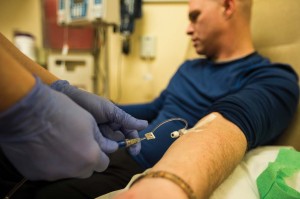
2. Patients receive liquid chemotherapy either through an IV in the arm or a port that is installed under the skin near the heart. Nurse Julie Gamble installs a new IV for Hendrickson’s treatment and selects green tape to match his tennis shoes.
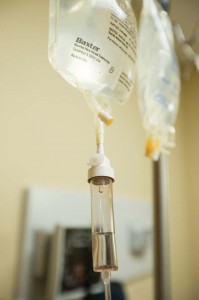
3. Because chemotherapy destroys all rapidly dividing cells, there are often side effects to treatment, including hair loss and digestive issues. It can also be extremely dehydrating. Most patients start their infusion day with a saline solution to boost hydration and anti-nausea medications.

4. The Oncology Pharmacy provides chemotherapy for all adult and pediatric inpatient and outpatient treatments, amounting to about 200 dispenses per day. Most chemotherapies can’t be stored long and are made on demand when the patient is ready. Pharmacy technicians Emily Rusinko, left, and Ashley Fudge mix the chemos under biologic safety cabinets, which protect them from the harmful chemicals and protect patients from any infectious agents. Some drugs start in liquid form while others must be reconstituted from a powder.
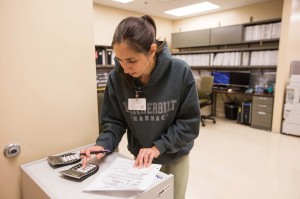
5. Orders arrive at the pharmacy via fax, and pharmacist Allison Balko double checks the orders. Hendrickson receives what Balko calls the “gold standard” for testicular cancer—a chemotherapy called BEP, named for the three drugs used in combination, bleomycin, etoposide and cisplatin. “It’s been around for years and is an effective therapy with amazing response rates,” Balko said.

6. For patients with cancers that lack a gold standard option like BEP, the pharmacy manages 225 studies for investigational therapies, each represented by a white binder on shelves lining the walls.
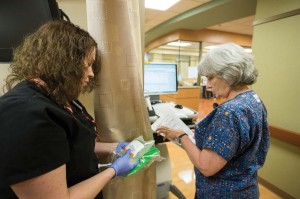
7. Gamble and nurse Debra Swaggerty verify that the pharmacy has provided the correct chemotherapy and check Hendrickson’s armband to ensure he is indeed Brent Hendrickson. Safety is a top concern and double checks are built into all work processes.
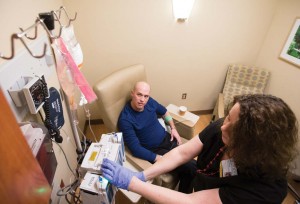
8. Gamble starts the chemotherapy infusion. Each drug is given one at a time and takes about an hour each. Hendrickson usually spends five hours in the Infusion Clinic. Other chemotherapy treatments can range from 15 minutes to 12 hours.

9. Volunteer Bob Laura stops by with a cart with sandwiches, snacks and drinks. It also has scarves and hats donated by community sewing and knitting groups. The Infusion Clinic often has pet visitors or musicians who provide entertainment.
2 Comments
Sorry, the comment form is closed at this time.

I went through VICC chemo/radiation 2005/2006. Very similar experience as noted in the post. The infusion unit has an amazing staff and deal with patients when we are at our worst… they truly blessed my life in so many ways!
Comment by Michele — June 19, 2014 @ 1:17 pm
The staff at Vanderbilt is AMAZING, I calls my infusion nurses my DREAM TEAM. The things and people they deal with on a daily bases.. scared angry patients taking their frustrations and fear out on them, getting attached to patients and then losing them, late nights early mornings.. takes a special person to deal with this and ALWAYS have a smile, comforting words and a hug when needed to do this. I thank y Dream Team with all of my heart and pray for them daily!
Comment by Terri Karns — June 19, 2014 @ 4:12 pm